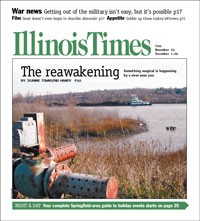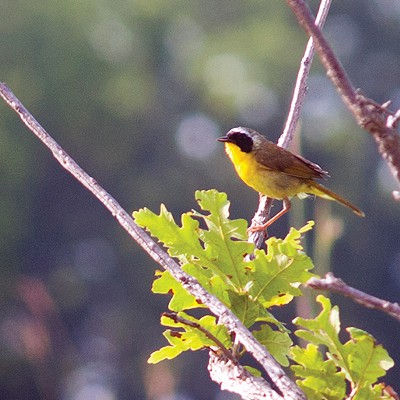"There can be no purpose more inspiriting than to begin the age of restoration, reweaving the wondrous diversity of life that still surrounds us." Ñ Edward O. Wilson, The Diversity of Life
After traveling north on Route 97 near the town of Havana, I see the Nature Conservancy's sign for the Emiquon Preserve, the only indication that I have indeed come to the right place. Although I realize that the work at Emiquon, one of the largest floodplain restorations in the country outside the Florida Everglades, has only just begun, still I am dismayed by what appears before me. Somehow I had believed that I might find at least a fragment, the smallest glimmer, of the landscape described in 1896 by scientist Stephen Forbes:
The forest itself, beginning at water's edge with a billowy belt of pale green willows, is an untamed tract of primitive wilderness. Elms and pecans and sycamores tower overhead. The shallow lakes and swamps are glorious in their season with the American lotus and the white water lily. Waterfowl abound, and fish lie in the shallows, basking in the summer sun. The microscopic life in a cubic meter of water is at certain times far in excess of the amount recorded for any other situation in the world.
Rather than this bountiful diversity in what had formerly been two shallow floodplain lakes named Thompson and Flag, I see instead acres and acres of dirt, interrupted only briefly by farm remnants. I pass a grain-loading facility surrounded by crumbling concrete and a cluster of tiny abandoned homes of former farm employees that now have the appearance of a miniature ghost town. With the harvest already complete, the ground appears so barren, so used.
Try as I might, I am unable to envision the scene that greeted Forbes. Others, however, can and have. A 1992 report by the U.S. National Research Council noted that the Illinois River -- one of the country's few remaining large-floodplain river systems -- has retained enough natural characteristics to permit its restoration. A decade after this report was released, the Nature Conservancy completed its purchase of more than 7,000 acres ofland for the project, at a cost of $18 million, and moved its field station from the town of Havana to its current location in the Emiquon area.
The project, however, is in its infancy as the Nature Conservancy continues to work with a group of more than 40 scientists of regional and national acclaim to determine the best methods for guiding Emiquon's restoration.
Some people see only reductionism in science, but if these efforts lead to the rebirth of a floodplain, I will call it magic.
In ancient times the Mississippi River ran along what is now the course of the Illinois before melting glaciers shoved it west 25,000 years ago. Because the glaciers also scoured out floodplains here, bigger than those of the Mississippi, this landscape has been supporting and inspiring human habitation for more than 12,000 years. It provided sustenance for the Native Americans who lived on the bluffs overlooking the diversity of wildlife in the floodplain and later provided sustenance for the souls of sportsmen. A report to the Rivers and Lakes Commission stated that "the fishery of the Illinois River is more valuable than that of any other fresh-water river fishery in the United States and is exceeded only by the Great Lakes and the Salmon industry of the Pacific Coast." Some called it the fishing capital of the world.
Millions of waterfowl and other migratory birds visited this habitat as well, coming here for rest and food during their annual migrations. We tend to think little of where the travels of birds take them or what brings them back to us. Yet each year we depend on their arrival -- they have returned, they have remembered us. For all time they have been not only a source of food and sport but also a portent of new beginnings and comfort to our subconscious. Upon the return of birds in spring, Henry David Thoreau reflected: "How happens it that the association it awakens are always pleasing, never saddening, reminiscences of our sanest hours. The voice of Nature is always encouraging." We expect them to return, always.
As if an omen of an inevitable future for the floodplain, however, Père Jacques Marquette wrote in 1673, "We have seen nothing like this river that we enter, as regards to its fertility of soil, its prairies and woods. . . . " Fertility of soil. In Illinois, fertile soil has always suggested attractive farmland, and this would be the fate of Thompson and Flag lakes. There was an outcry, followed by lawsuits, in a desperate attempt to hold onto land that by its very nature must surely belong to all. But the sportsmen and the scientists and the wildlife would lose. This area had once been considered public property because of the navigable waters of Thompson Lake and its connection to the river, but the Illinois Supreme Court later deemed it private land. In 1924, channels were run to pumping stations to put water back in the river, the fish now the only impediment: 600,000 pounds of fish were harvested as the lakes were drained; the rest -- twice that amount -- perished before the process was over. Lakes and wetlands were drained, levees were built that separated the river from its floodplain, crops were planted, and bottomland hardwood forests were cleared.
Now, after 80 years and great deal more knowledge, the original purpose of this land, nature's purpose, has been deemed the most beneficial. Now we know that floodplains filter sediment and pollutants while providing storage for water, helping keep floods from reaching catastrophic levels. Now, people are flocking to this restoration project to provide information, assistance, and, like Dr. Michael Lemke and Dr. Keith Miller of the University of Illinois at Springfield, a chance to educate the future keepers of Emiquon.
I recently attended a talk regarding UIS's role at Emiquon, "The Floodplain of Dreams," the title another indication of the almost miraculous nature of the project. The university will be setting up its own field office for the purpose of facilitating research and education, using one of the old farm buildings still standing on the floodplain. The building will be moved to the other side of Route 97, not far from the Nature Conservancy headquarters, and there it will hum with new life: lab facilities, classrooms, even a Webcam.
It is at this presentation that I began to understand the enormous importance of this restoration. After Lemke spoke about the unique and special nature of "the mosaic of wetlands, lakes, and rivers that had worked together and intermingled to form Emiquon," we viewed a brief video, produced by the Nature Conservancy, that informed us that the Illinois River is one of 89 large-floodplain rivers that exist around the globe including the Amazon, the Nile, and the Mississippi -- "Earth's last great places."
"I love that video," Lemke remarked, "because it ranks our river with the Nile and the Amazon. I think sometimes we have treasures so close to us that we sometimes don't remember that they are treasures."
Lemke continued to layer one amazing fact on another, telling us that the Emiquon area had not been overlooked by scientists, that indeed studies from the area, conducted by Stephen Forbes, have served as the foundation of American ecology.
It was in Havana that a new station would come into being that addressed an untouched subject in the United States, the biology and ecology of a great river system in North America. Forbes' work would attract attention even overseas, and Forbes himself tells of how a leading American zoologist wrote him that "the Illinois River promised to become soon the best known -- because the best studied -- of any river in the world."
The Stephen A. Forbes Biological Station continues to do important work at the Chautauqua National Wildlife Refuge, across the river from Emiquon; studies produced there provide baseline data about the state of Emiquon. And the historical knowledge amassed by Forbes, now known as "a giant of American ecology," is an extraordinary legacy.
I am, in fact, hoping to meet two former employees of the Forbes Biological Station at the Dickson Mounds Museum who, although now retired, are adding their years of study to the Emiquon project. I take another look at the preserve-to-be before turning onto a road that leads to the museum. I recall that during his presentation Miller had said with awe in his voice, "It is a magical place, and this is a magical time."
I cannot help thinking after seeing Emiquon for the first time that it will indeed take a little magic for this project to succeed.
Despite a lack of written history, the very existence of Native Americans on the bluffs overlooking the floodplain provides early testament to the vast natural abundance of Emiquon, a name taken from their language. Proof they were here was first discovered in burial mounds that were originally excavated by two amateurs, the Dickson brothers. In addition to their work, however, the first archaeological dig involving modern methods, conducted by a team from the University of Chicago, would take place in this region as well. How remarkable it is that the beginnings of modern ecological study and modern archaeology would spring from the same small area. The Dickson Mounds Museum officially came into being in 1972, dedicated to relaying the story of the lives of these early people. Now, together with the Nature Conservancy and UIS, the museum's staff will assist the Emiquon project through education efforts.
It is a special day at the museum, a day on which the human and nonhuman history of Emiquon will come together as ancient societies, scientific studies, and the abundance of winged creatures are jointly honored. On entering the museum, I immediately locate the Special Exhibits Gallery, where the winged residents of the Illinois River valley have taken center stage in an exhibit titled Sky Dance: A Look at the Migratory Water Birds of Illinois.
For me, this is the most exciting aspect of the Emiquon restoration -- the return of the wildlife, the return of the birds. I realize that this is what I had missed the most as I drove by the preserve -- the sight of birds. In 1916, Jim Paul of Peoria reported, "There were thousands and thousands of ducks on the water. Somebody scared them, and when they took flight, they were so thick they completely shut out the sun . . ." Though they had been deprived for 80 years of their former habitat at Emiquon, I suppose I had somehow expected the birds to be holding onto hope or had expected that they would somehow know an enormous change was about to take place -- that it was almost time for them to return.
But the birds I looked for in the fields are here instead, in the museum, memorialized and displayed in glass cases and mounted to the ceiling in simulated flight over our heads. Panels on the walls tell the story: "Today, absorbed in the hustle and bustle of life, we are less linked to the cycles of nature and largely unaware of the thousands of feathered travelers above or dwelling in our midst."
Two men at this museum today are, unlike most of us, acutely aware of the cycles and the travelers, and they are to be honored for their knowledge. Dr. Stephen Havera and Frank Bellrose have dedicated their lives to the birds of the area through their work at the Forbes Biological Station.
The crowd adjourns to the auditorium, and I find the thoughts and sights of the day gradually fitting together into a cohesive whole as each speaker takes the stage. We hear how Bellrose began waterfowl studies in 1938, work that would later lead to recognition in the form of the Aldo Leopold Medal, the highest honor bestowed by the Wildlife Society. More recognition would follow when Gov. Jim Thompson declared Feb. 1, 1988, Frank Bellrose Day. We next learn that Havera took up the directorship of the station in 1982 and that he has worked his whole life for the establishment of the Emiquon preserve. The knowledge of these two men, combined with that of Forbes and many others connected with the station, is surely unprecedented.
Then Doug Blodgett, director of the Nature Conservancy's Illinois River Project at Emiquon, rises to speak.
"Today is a time again of great hope, of great expectations for the Illinois River," he says, and I hear in his statement again the wish for magic, the evidence of something breathtaking. I begin to believe as he speaks that the transformation is truly possible. He lists an heretofore-unimaginable assembly of partners -- the Illinois State Museum; the U.S. Fish and Wildlife Service's nearby Emiquon National Wildlife Refuge, providing additional acres of protection; the Chautauqua National Wildlife Refuge, across the river, furnishing additional refuge and invaluable information.
"We have a unique opportunity to put into conservation about 14,000 acres of bluff-to-bluff habitat," he proclaims.
Blodgett's next words mirror my thoughts on all the connections, biological and human, that are being constructed: "John Muir said when we try to pick out anything by itself we find that it is hitched to everything else in the universe, and I think there are few places on earth that provide more validity for this statement than the complexity of nature and society in a place like the Illinois River valley."
The lights are then dimmed and a video presentation depicts stirring scenes of waterfowl, many with their young, as a Native American flute plays an accompaniment to the images.
Leaving the auditorium, I seek out Havera. According to the exhibit, more than 90 percent of Illinois wetlands are gone, and 78 of the 148 species that were common here are now seldom seen. How long, I ask Havera, will it take before the birds return? How will they know to come back? Surely after 80 years of agriculture the process will be slow.
Havera has amazing answers for me: Yes, the area has not been able to support the phenomenal numbers of birds that once migrated here, and this, in turn, has caused more stress on other areas. But no, it will not take forever for the habitat to regenerate and for the birds to return.
He cites the success of a 2,000-acre restoration project at Spunky Bottoms, also on the Illinois River, that in just four years has seen amazing transformation. Seed banks of native plants that had lain dormant in the soil throughout the period of agriculture started sprouting in just one year after the return of the water. The same is expected to happen here. Creatures are rediscovering Spunky Bottoms, and they will quickly rediscover Emiquon, he tells me.
"It is like the opening of a new restaurant in town," he says "They will all flock to it."
Soon the pumping will stop -- in the spring, with any luck -- and water from a deep aquifer will at last be allowed to rise. There has been much for the Nature Conservancy to contend with: underground pipes and the remnants of a 7,000-head cattle farm and, perhaps, other surprises. But, as Blodgett says, "If all goes well . . ."
I now believe that all will go well.
A leading environmental organization, a museum, a university, a historically rich biological station -- in an echo of the web of life that first brought about the existence of Emiquon, these humans too are forming a web, a connection that will bring about its restoration. It is a place with a formidable history and possibly a formidable future.
This time when I drive by the Emiquon Preserve I see more than dirt. I see water and vegetation and birds -- many birds. I can now imagine the vision presented to Père Marquette and Stephen Forbes, as well as the vision of all of the people I have met today who must surely see beauty in their own minds' eyes when they look at Emiquon. In 1880, Forbes wrote:
From the consequent human interferences with the established system of things, numerous disturbances arise -- many of them full of danger, others fruitful of positive evil. Oscillations of species appear not less injurious to man than to the plants and animals more directly involved.
We finally know this to be true, and we now understand what we have lost.
Once we waved our wands to conjure up productive fields, but we are about to wave our wands again.






















